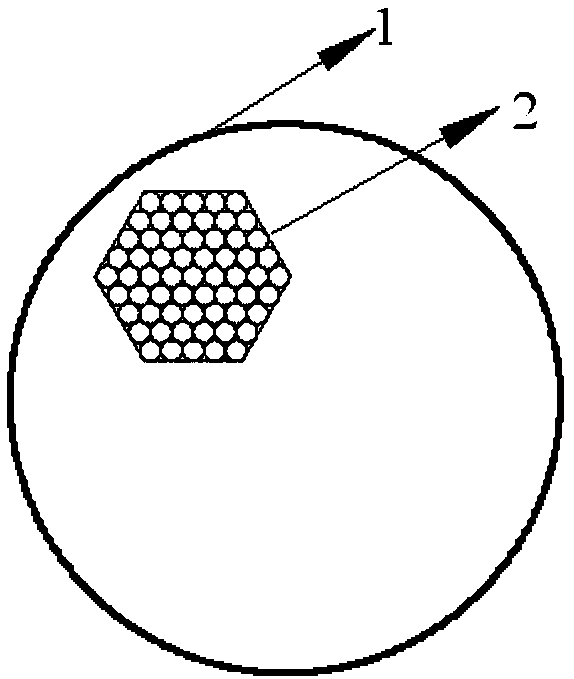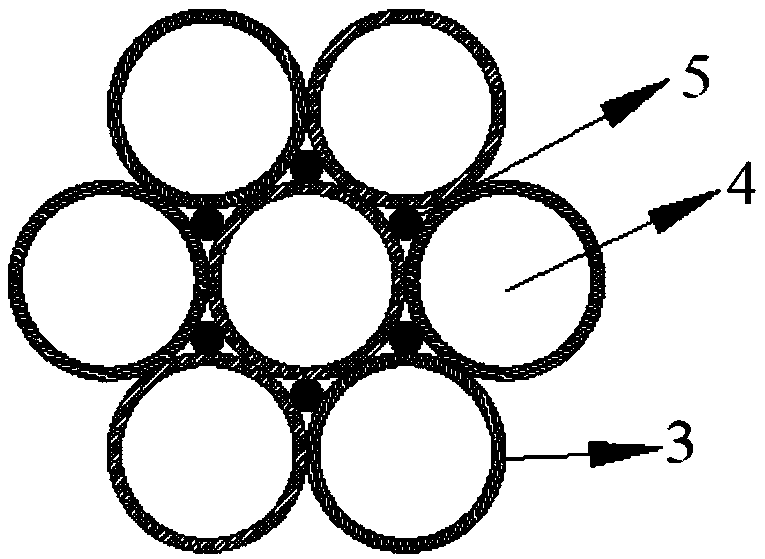Low-refractive-index glass used for drawing and forming optical fiber panel and preparation method thereof
A low-refractive index, fiber-optic panel technology, applied in glass manufacturing equipment, glass production, bundled optical fibers, etc., can solve the problems of low pass rate of performance indicators of fiber-optic panel segments, loss of raw materials and auxiliary materials, and high production costs. The effect of visible light radiation transparency, good heat resistance and chemical stability, good high temperature crystallization performance
- Summary
- Abstract
- Description
- Claims
- Application Information
AI Technical Summary
Problems solved by technology
Method used
Image
Examples
Embodiment 1
[0062] At first, select raw material according to table 1 embodiment 1 glass composition, and require Fe in glass raw material 2 o 3 Strictly controlled, the finished glass Fe 2 o 3The content is less than 150PPm, so that the ingredients meet the chemical composition of the glass in Table 1, and then use a platinum crucible to melt at 1550°C for 8 hours. After the glass batch is melted into a homogeneous glass melt, pour the glass melt into the preheated A good size is 70mm x 70mm x 10mm in a heat-resistant steel mold for casting, and then annealed. Its test performance is shown in Table 1, (1) the refractive index is 1.46; (2) the average linear expansion coefficient of 30-380°C is 80×10 -7 / °C; (3) The expansion softening point temperature of glass is 693°C; (4) The viscosity is 10 7.6 The softening point temperature of the glass at poise is 763°C; (5) The crystallization temperature of the glass is 970°C.
Embodiment 2
[0064] Select raw material by table 1 embodiment 2 glass composition, and require Fe in glass raw material 2 o 3 Strictly controlled, the finished glass Fe 2 o 3 The content is less than 150PPm, so that the ingredients meet the glass chemical composition in Table 1, and then use a platinum crucible to melt at 1500°C for 9 hours. After the glass batch is melted into a homogeneous glass melt, pour the glass melt into the preheated A good size is 70mm x 70mm x 10mm in a heat-resistant steel mold for casting, and then annealed. The basic properties of the samples are shown in Table 1. (1) The refractive index is 1.46; (2) The average linear expansion coefficient of 30-380°C is 78×10 -7 / °C; (3) The expansion softening point temperature of glass is 688°C; (4) The viscosity is 10 7.6 The softening point temperature of the glass at poise is 759°C; (5) The crystallization temperature of the glass is 960°C.
Embodiment 3
[0066] Select raw material by table 1 embodiment 3 glass composition, and require Fe in glass raw material 2 o 3 Strictly controlled, the finished glass Fe 2 o 3 The content is less than 150PPm, so that the ingredients meet the chemical composition of the glass in Table 1, and then use a platinum crucible to melt at 1600°C for 6 hours. After the glass batch is melted into a homogeneous glass melt, pour the glass melt into the preheated A good size is 70mm x 70mm x 10mm in a heat-resistant steel mold for casting, and then annealed. The basic properties of the samples are shown in Table 1. (1) The refractive index is 1.49; (2) The average linear expansion coefficient of 30-380°C is 86×10 -7 / °C; (3) The expansion and softening point temperature of glass is 685°C; (4) The viscosity is 10 7.6 The softening point temperature of the glass at poise is 748°C; (5) the crystallization temperature of the glass is 930°C.
PUM
| Property | Measurement | Unit |
|---|---|---|
| crystallization temperature | aaaaa | aaaaa |
| crystallization temperature | aaaaa | aaaaa |
| crystallization temperature | aaaaa | aaaaa |
Abstract
Description
Claims
Application Information
 Login to View More
Login to View More - R&D
- Intellectual Property
- Life Sciences
- Materials
- Tech Scout
- Unparalleled Data Quality
- Higher Quality Content
- 60% Fewer Hallucinations
Browse by: Latest US Patents, China's latest patents, Technical Efficacy Thesaurus, Application Domain, Technology Topic, Popular Technical Reports.
© 2025 PatSnap. All rights reserved.Legal|Privacy policy|Modern Slavery Act Transparency Statement|Sitemap|About US| Contact US: help@patsnap.com



